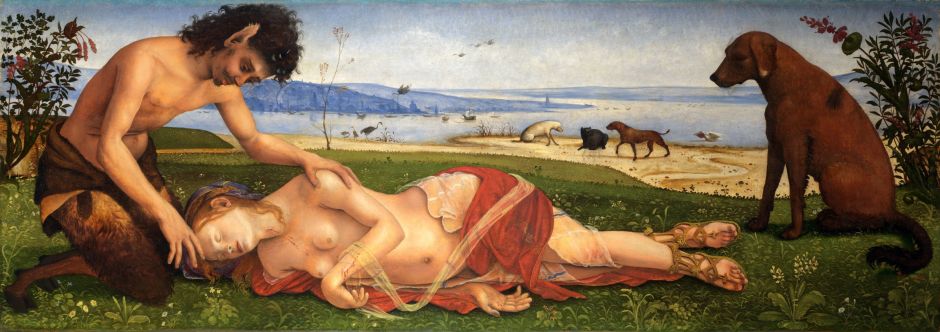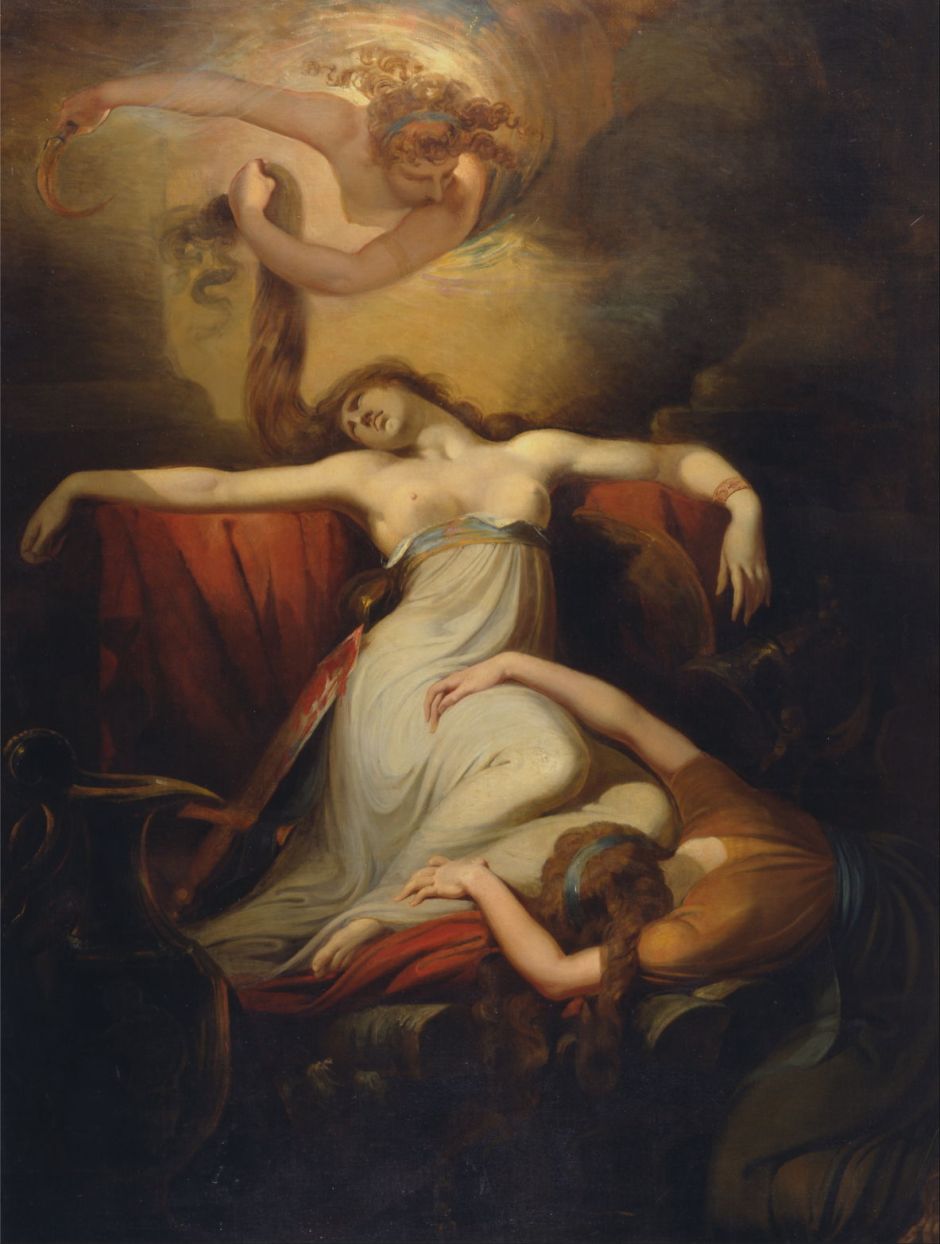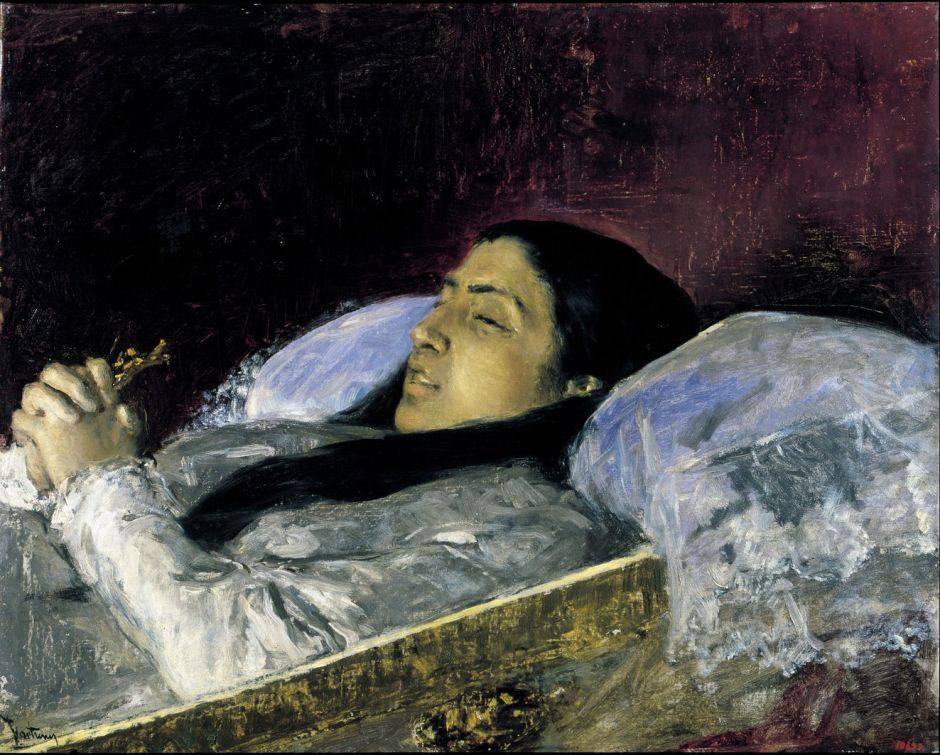Reading visual art: 161 Death
Although birth hasn’t proved such a popular theme in paintings, there are countless depictions of death. Dominant among them in European works are those of the Crucifixion, but in this brief survey I concentrate on those showing figures from myth, history and contemporary life, particularly those of deathbed scenes, and omit religious paintings entirely.
Adonis is perhaps the only figure whose birth and death have been popular in paintings. Following his strange birth from the myrrh tree, when he was a young adult he bled to death after he had been gored by a wild boar while he was hunting.

Hendrik Goltzius’ startlingly foreshortened projection of the Dying Adonis from 1609 pushes his face and head into the distance and makes their features almost unreadable, while his feet take pride of place and you can even read their soles.

Piero di Cosimo’s wonderful painting of a dying nymph uses the full width of a panoramic panel to show a satyr with his goat legs and distinctive ears, ministering to the nymph, who has a severe wound in her throat. At her feet is a hunting dog, with another three in the distance. Sometimes claimed to show the death of Procris by a javelin thrown by her husband Cephalus, this tells a different and unidentified story.
The death of Dido is more easy to identify, particularly in this depiction by Henry Fuseli, from 1781.

Dido has mounted her funeral pyre, and is on the couch on which she and Aeneas made love. She then fell on the sword which Aeneas had given her, and that rests, covered with her blood, beside her, its tip pointing up towards her right breast. Her sister Anna rushes in to embrace her during her dying moments, and Jupiter sends Iris (wielding a golden sickle) to release Dido’s spirit from her body. Already smoke seems to be rising up from the pyre, confirming to Aeneas that she has killed herself, as he heads towards the horizon, and the eventual founding of Rome.
The story of lovers Pyramus and Thisbe and their tragic deaths has been popular with painters since classical times. When they arrange to meet outside the city, she flees from a lioness, leaving her bloodied cloak. He then arrives and assumes that she has been killed by the lioness and falls on his sword. She returns to find him dying, and falls on his sword so they can be reunited in death. Their spilt blood turns the fruit of the mulberry bush from white to red.

This version from the ruins of Pompeii includes all the main cues, with the lioness in the distance, and a mulberry tree with its white fruit. Its composition has remained in use for the two millennia since then.
More recent legends, particularly those of King Arthur, have formed the basis for some notable painted deathbed scenes.

In James Archer’s The Death of King Arthur from about 1860, the dying Arthur is surrounded by four women, as the black boat approaches the beach behind them. At the right, the ghostly figure of an angel holding a chalice is materialising, in accordance with Sir Thomas Malory’s popular literary account.
Many historical figures have been portrayed in their final moments.

In Paul Delaroche’s Death of Elizabeth I, Queen of England (1828) the haggard queen is shown slumped on a makeshift bed on the floor, putting her low in the painting. Her maids and other female attendants are in distress behind her, supporting the pillows on which her head rests. I presume that the male kneeling by the queen and extending his right hand towards her is Robert Cecil, leader of the government at the time, and behind him are other members of the Privy Council of England, who were shortly to install Elizabeth’s successor.

Benjamin West’s best-known painting of The Death of General Wolfe (1770) shows a scene from an almost uniquely brief battle between British and French forces on 13 September 1759, which lasted only an hour or so. At the end of their three months siege of the French city of Quebec, Canada, British forces under the command of General Wolfe were preparing to take the city by force. The French attacked the British line on a plateau just outside the city.
Within minutes, Wolfe suffered three gunshot wounds, and died quickly. The French commander, General Louis-Joseph, Marquis de Montcalm, was also hit by a musket ball, and died the following morning. The British line held, and the French were forced to evacuate the city, ultimately leading to France ceding most of its possessions in North America to Britain, in the Treaty of Paris of 1763. Wolfe’s death was quickly seen as the ultimate sacrifice of a commander in securing victory, West’s underlying theme here.
Just over twenty years later, it was the turn of the French Revolution to provide a more equivocal hero.

On the morning of 13 July 1793, Charlotte Corday, a young woman from Normandy, turned up at the Paris house of Jean-Paul Marat, one of Revolution’s most influential radicals, asking to see him; his fiancée turned her away. She gained entry later that evening, and started giving him the names of some local counter-revolutionaries. While he was writing them down, she drew a kitchen knife with a 15 cm (6 inch) blade from her clothing, and plunged it into Marat’s chest, killing him rapidly.
David’s famous painting shows Marat’s body slumped over the side of his bath, the murder weapon and his quill both on the floor, the pen still in his right hand, and a handwritten note in his left hand. Corday was executed in public by guillotine on 17 July. Marat became a martyr for the cause, after his friend David had organised one of the spectacular funerals for which he had become known.

When Théodore Géricault, who had painted The Raft of the Medusa in 1818-19, died in Paris on 26 January 1824, the young and promising history painter Ary Scheffer painted his tribute as The Death of Théodore Géricault (1824). At the artist’s bedside are his close friends Colonel Bro de Comères and the painter Pierre-Joseph Dedreux-Dorcy, and the wall of the room is covered by his paintings.

When Claude Monet’s first wife was dying in the late summer of 1879, he painted his tribute to her in Camille Monet on her Deathbed (1879). She appears to be surrounded by diaphanous feathers that rise on either side of her head to form angelic wings. She was only 32, and they had two children.

By the Deathbed (1895) is Edvard Munch’s painting from memory of his sister Sophie resting in her deathbed in 1877, when she was 15 and the artist wasn’t quite 14 years old. She died of tuberculosis, an unfortunately common event at the time. Munch explained that, when painting from memory like this, he depicted only what he could remember, and was careful to avoid trying to add details that he no longer saw. This explains its relative simplicity.
Sophie is seen from her head, looking along her length to her feet, her figure compressed into almost nothing by extreme foreshortening. Her deathbed resembles the next step, in which her body will be laid out in a coffin prior to burial. More than half the painting is filled by the rest of the family, father with his hands clasped in intense prayer. At the right is their mother, who had died of tuberculosis herself nearly nine years earlier.

Like Manet and the French Impressionists, Marià Fortuny painted motifs that challenged social attitudes of the day. His portrait of Miss Del Castillo on her Deathbed from 1871 shows a similar scene to Monet’s later painting above.
Sometimes, deathbed and other posthumous portraits prove too great a challenge.

Maria Munk, known as Ria, had been engaged to the actor and writer Hanns Heinz Ewers; when he called off their engagement, she committed suicide just after Christmas in 1911, by shooting herself in the chest. Gustav Klimt was commissioned by Ria’s family to paint a posthumous portrait of her, and first made Ria Munk on her Deathbed, initially completed in 1912 but here dated to 1917-18. She is manifestly dead, and surrounded by floral tributes. The family rejected the work, finding it too distressing, and asked Klimt to depict her when she had still been alive, from photographs.
A second portrait completed in 1916 was also rejected, although there’s doubt about the identity of the painting, and the reason for its rejection. Klimt started his third attempt in 1917, and was still working on it early the following year. It was clearly going to be one of his richly decorated paintings, with abundant colourful flowers in the background, and brilliant peppers and other vegetables. In early January 1918, Klimt caught the deadly influenza that had just started to spread across Europe. He quickly developed pneumonia, suffered a stroke, and died on 6 February 1918.





